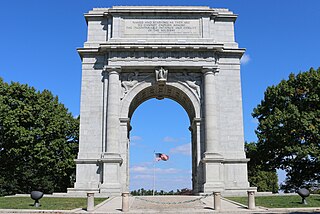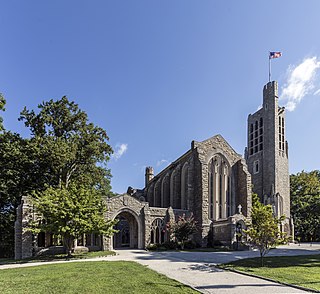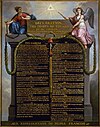
Friedrich Wilhelm August Heinrich Ferdinand von Steuben, also referred to as Baron von Steuben, was a Prussian military officer who played a leading role in the American Revolutionary War by reforming the Continental Army into a disciplined and professional fighting force. His contributions marked a significant improvement in the performance of U.S. troops, and he is consequently regarded as one of the fathers of the United States Army.

The Village of Valley Forge is an unincorporated settlement. It is located on the west side of Valley Forge National Historical Park at the confluence of Valley Creek and the Schuylkill River in Pennsylvania. The remaining village is in Schuylkill Township of Chester County. It once spanned Valley Creek into Montgomery County. The name Valley Forge is often used to refer to anywhere in the general vicinity of the park. Many places will use the name even though they are actually in King of Prussia, Trooper, Oaks, and other nearby communities. This leads to some ambiguity on the actual location of the modern village. There is a partial re-creation of the historic village from the time of the American Revolution that is located just within the outskirts of the park.

USS Valley Forge was one of 24 Essex-class aircraft carriers built during and shortly after World War II for the United States Navy. The ship was the first US Navy ship to bear the name, and was named after Valley Forge, the 1777–1778 winter encampment of General George Washington's Continental Army. Valley Forge was commissioned in November 1946, too late to serve in World War II, but saw extensive service in the Korean War and the Vietnam War. She was reclassified in the early 1950s as an attack carrier (CVA), then to an antisubmarine carrier (CVS), and finally to an amphibious assault ship (LPH), carrying helicopters and Marines. As a CVS she served in the Atlantic and Caribbean. She was the prime recovery vessel for an early uncrewed Mercury space mission. After conversion to an LPH she served extensively in the Vietnam War. Valley Forge was awarded eight battle stars for Korean War service and nine for Vietnam War service, as well as three Navy Unit Commendations.

Silent Running is a 1972 American environmental-themed science fiction film. It is the directorial debut of Douglas Trumbull, and stars Bruce Dern, Cliff Potts, Ron Rifkin, and Jesse Vint.

Valley Forge National Historical Park is the site of the third winter encampment of the Continental Army during the American Revolutionary War from December 19, 1777 to June 19, 1778. The National Park Service preserves the site and interprets the history of the Valley Forge encampment. The park contains historical buildings, recreated encampment structures, memorials, museums, and recreation facilities.

Valley Forge Military Academy and College (VFMAC) is a private boarding school and military junior college in Wayne, Pennsylvania. It follows in the traditional military school format with army traditions. Though military in tradition and form, the high school portion of VFMAC, Valley Forge Military Academy, is a college-preparatory boarding institution specializing in student leadership. VFMAC's administration is composed almost entirely of current or retired military and the board of trustees is almost entirely alumni. Some graduates pursue careers in the armed services and VFMAC has graduated one Rhodes Scholarship recipient.

Pennsylvania was the site of many key events associated with the American Revolution and American Revolutionary War. The city of Philadelphia, then capital of the Thirteen Colonies and the largest city in the colonies, was a gathering place for the Founding Fathers who discussed, debated, developed, and ultimately implemented many of the acts, including signing the Declaration of Independence, that inspired and launched the revolution and the quest for independence from the British Empire.
Valley Forge was a Continental Army winter encampment during the American Revolutionary War.

Valley Forge is a 1934 three-act historical play by Maxwell Anderson, about the winter that George Washington spent in Valley Forge. It has four settings, a large cast, and slow pacing. It concerns Washington's struggle to keep faith with his soldiers amidst intrigue from General Howe and the British Army in Philadelphia, and despite little support and outright treachery from the Continental Congress. Like the playwright's earlier historical dramas, Elizabeth the Queen and Mary of Scotland, the play's action, though set in historical circumstances, is fictional.

Arnold Friberg was an American illustrator and painter noted for his religious and patriotic works. He is perhaps best known for his 1975 painting The Prayer at Valley Forge, a depiction of George Washington praying at Valley Forge. He is also well known for his 15 "pre-visualization" paintings for the Cecil B. DeMille film The Ten Commandments which were used to promote the film worldwide and for which he received an Academy Award nomination.

The Valley Forge Pilgrimage and Encampment is the oldest annual scouting event in the world. It was first held on February 22, 1913, and has been held every year since. The event is hosted by the Cradle of Liberty Council and commemorates the soldiers of the Continental Army who braved the winter of 1777-78 at Valley Forge. Each year more than 2,000 brave the winter chill of the Delaware Valley to participate.

Washington Memorial Chapel in Valley Forge National Historical Park is a national memorial dedicated to General George Washington and an active Episcopal parish in Valley Forge, Pennsylvania. The church was inspired by a sermon preached by Anglican minister Reverend Dr. W. Herbert Burk, founder and first rector of the parish. The building was designed by architect Milton B. Medary. It was listed on the National Register of Historic Places on May 1, 2017, and is undergoing an active restoration campaign.
Maximilian Josef Sommer is a retired German-American stage, television, and film actor.
Kenneth Michael Schroy is a former American football safety who played eight seasons in the NFL for the New York Jets.

Valley Forge was the winter encampment of the Continental Army, under the command of George Washington, during the American Revolutionary War. The Valley Forge encampment lasted six months, from December 19, 1777 to June 19, 1778. It was the third and harshest of the eight winter encampments that Washington and the Continental Army endured during the war.
This bibliography of George Washington is a selected list of written and published works about George Washington (1732–1799). A recent count has estimated the number of books about George Washington at some nine hundred; add scholarly articles with Washington's name in the title and the count climbs to six thousand.
Valley Forge Christian College v. Americans United for Separation of Church and State, 454 U.S. 464 (1982), was a decision by the Supreme Court of the United States in which the court refused to expand the Flast v. Cohen exception to the taxpayer standing rule.

America, also called Love and Sacrifice, is a 1924 American silent historical war romance film. It describes the heroic story of the events during the American Revolutionary War, in which filmmaker D. W. Griffith created a film adaptation of Robert W. Chambers' 1905 novel The Reckoning. The plot mainly centers itself on the Northern theatre of the war in New York, with romance spliced into the individual movie scenes.

General George Washington used a pair of campaign tents throughout much of the American Revolutionary War. In warm weather, he used one for dining with his officers and aides, and the other as his military office and sleeping quarters. Canvas panels and poles from both tents survive, and are currently owned by four separate historical organizations.












